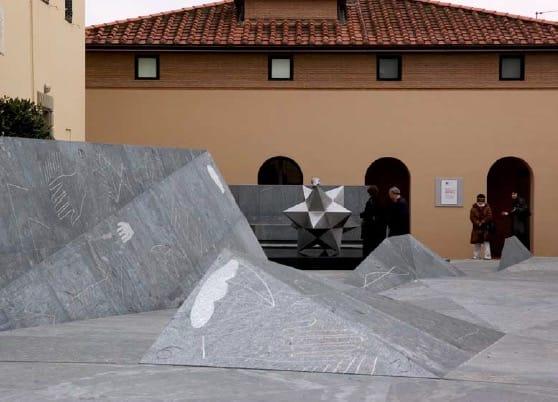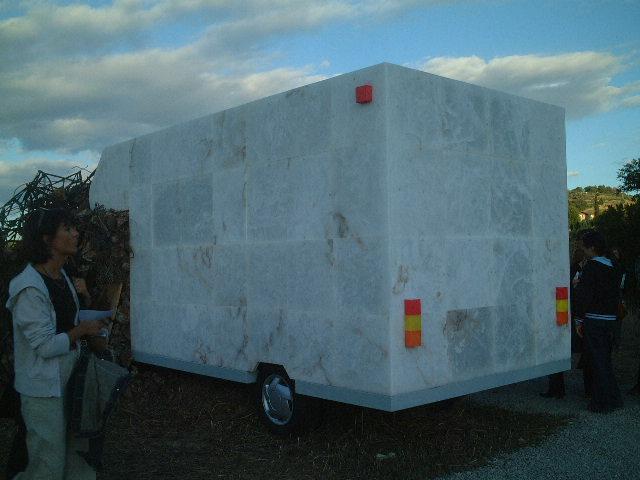Interview with Mario Cristiani – Associazione Arte Continua and Co-Founder Galleria Continua
Over thirty years ago one of the best known Italian galleries on the world scene was born: Galleria Continua was founded by Mario Cristiani, Lorenzo Fiaschi and Maurizio Rigillo.
A strong sense of belonging to the community, to the value of art for our society, where works of art by great artists inserted above all in peripheral contexts for a fruition within everyone’s reach led to the birth, at the same time, of the Continuous Art Association.
The project and fundraisers, still in progress and in full development today, have made it possible to realize ideas and visions inspired by the idea of corporate social responsibility.
Among the projects carried out: Arte all’Arte. Art Architecture Landscape, Renaissance Nascimento. Art Energy Sustainability, Art x Wine = Water, Art Pollino, UMOCA.
In this interview with one of the founders of Galleria Continua and the Associazione Arte Continua, Mario Cristiani, we discover what has happened in these thirty years of activity, the artists involved and the latest projects carried out in Tuscany between Prato, Florence and the involvement of the Uffizi Galleries.
Even in times of pandemic the Associazione Arte Continua does not stop. The latest major project sees the collaboration, on the occasion of the celebrations of Monday, with the Uffizi Galleries and the Municipality of Florence. Tell us about the project
MARIO CRISTIANI: The Arte Continua Association that I founded with Lorenzo Fiaschi and Maurizio Rigillo now 31 years ago, has had a long period of activity focused more on fundraising Arte x Vino = Water than on projects in the cities. donated € 2,000,000 in different parts of the world.
Now with the emergency triggered by the pandemic, we have thought that the pendulum of our activities must return to the places we started from and can finally find the support and involvement of other public and private partners, who can tackle the issue of regeneration of a more balanced relationship between city and countryside, through the involvement of geographically similar areas and prevailing activities.
The goal is to start from the cities of art, to make art in the cities become a basic element, and not a last-minute addition, so it is enough to do some murals of the first one that happens or that the politician on duty to create the redevelopment of the suburbs or an urban regeneration.
It is not enough and you cannot get away with these improvisations to please the many or the few followers of Instagram, precisely for this apparent ease we must insist even more on what, how and who to involve in public discourse. This applies whether the intervention is carried out by private individuals or whether it is carried out by public administrations.
It is essential to reduce possible errors in making projects that are visible to all. Those who do not have the possibility of access – either for cultural training or for lack of economic resources – must be able to find in the public space that sense of sharing and accessibility of the works selected and proposed by professionals in the sector, curators or non-profit structures like ours that , they act to involve artists from the international art community who have their own idea of the world.
It is important where they come from, but what matters is where they know how to go and where they can lead us, to us who are not artists and above all how likely they are to last over time.
Our project started in the countryside, it went towards the villages first and then through the industrialized countryside and the rethinking of the industrial areas towards the breaking of the idea of the suburbs, for which we are working on the idea of artists’ council houses, which make it clear that if it is the whole community that raises its level, and stimulates the improvement of every part of the built-up area, starting with those who are not normally called to participate and feel the less part of the community, everything can rise in level.

Gilberto Zorio
Scandicci 2006
Foto Ela Bialkowska
©Associazione Arte Continua, San Gimignano – Italy
In 2020, 30 years have passed since the foundation of the Associazione Arte Continua, founded together with the Galleria Continua: what has changed since then for the association?
MARIO CRISTIANI: Before we were strangers who spoke to a few close friends, today thanks to the great work we have done on a global scale, especially with the Galleria Continua, and our entrepreneurial ability – a bit crazy when evaluated in terms of a normal business – we can make people understand and spread the possibility of art not only to change individuals and the spaces they own, but to create synergies and correspondences between the inside and the outside.
Perhaps truly starting a different relationship between cities and countryside, between large “re-forested” or “re-ruralized” centers, allowing us a less dramatically dangerous relationship, especially for the future of people.
I am convinced that the artists of the international art community can give us indications of how to venture into a future that is once again open to hope, rather than to the growing threat to the survival of our species and the others that we will carry after us, if we do not change our path quickly. and we take the right direction.
Perhaps our reading of considering the countryside prompted us to go to China in 2004, then to the countryside around Paris, and then to Cuba and then to Brazil, before returning to Rome and even more to central Paris in the Marais

Mimmo paladino
Vinci
Foto Ela Bialkowska
©Associazione Arte Continua, San Gimignano – Italy
It is now on a national scale that we start again with “Arte All’Arte” in the small villages, and with the cities of the future. For now, involving Prato and Florence, and then extending the action we had started in Vinci and Scandicci, where we carried out in alliance with the municipalities, the European project “Arte all’Arte Rinascimento – Nascimento, technical art, technology and science” with the aim of creating an environmental technological artistic district that can be a model for rethinking the entire industrialized countryside and the cities that are part of it.

Abete, 2013
acciaio inossidabile, bronzo
2240 × 600 × 600 cm
Photo by Ela Bialkowska, OKNOstudio
Photo Courtesy Associazione Arte Continua APS
Why should city public administrations bring more Contemporary Art to our cities in contact with people?
MARIO CRISTIANI: It is a right to information and a way to allow people to feel in the world, even from a small place or on the edge of a built-up area. It is an inspiration for young people to think that Culture and Art are ways to build their identity and also a possibility of social mobility as well as the ecology of gaze and thought. And above all not to let the market alone dictate the law, also allowing artists and gallery owners to work together for an objective that concerns everyone and in which their skills, even for free, can allow to give space to the cooperative part as well as the competitive one.

Anotony Gormley
Piazza duomo Prato,
Foto Ela Bialkowska
©Associazione Arte Continua, San Gimignano – Italy
For this reason, it is essential that the non-profit structure can support the commercial one, paraphrasing the Latins, philosophizing today more than ever makes sense and will allow us to overcome the stage of survival. And then we find Dante and his “facts you weren’t living like brutes.” It is wonderful to find two great artists capable of creating, with their works, a strong dialogue with the context: in Prato in Piazza Duomo “SHY” by Antony Gormley, which will remain until mid-July, and in Florence in Piazza della Signoria, until mid-September, Giuseppe Penone’s “Abete” will be found, which will be followed by the exhibition “Trees in verse” at the Uffizi Galleries from 28 June.

Fai spazio, prendi posto – Making Space, Taking Place, 2004
7 casting in spheroildal graphite iron, different sizes
Centro Commerciale Val d’Elsa, Fortezza, Largo Gramsci, Parco del Vallone, Piazza Cavour, Ponte Ex Fassati, Stazione FFSS (binario 2), Poggibonsi, Arte all’Arte IX
Foto Ela Bialkowska
©Associazione Arte Continua, San Gimignano – Italy
What is the future of the Association for the next 30 years?
What is the future for the next 30 years Well, before moving on to a better life I would like to see the artist’s council houses built as habitable sculptures, with energy saving, the construction of air factories, with neighborhood gardens, in the context of urban reforestation.
In these new or old renovated houses, some apartments should be allocated for young artists, in proportion to the number of tenants, and exhibition spaces that connect the contemporary art museum in the area or even where there is no dedicated structure, to give opportunities to grow and compete for the improvement and maintenance of the daily life space generated by the artists.
Transforming industrialized countryside areas, always with the same system, with those who save energy, recover water and purify sludge, reduce co2 emissions, participate in reforestation by having verified and internationally credible certifications, have the opportunity to tax deductions or cost reduction in order to transform the exterior of the sheds into works of art.
In any case, our association wants to ask artists who are friends of the international art community to lower their remuneration, and participate with us, in this case as a non-profit activity, to start this path, I am sure that people ready to do there is a step in this direction and there will be more and more. We are ready.
of the Association?

Illuminated Sanctuary of Empty Sins, 2001
Alabastro, metallo, materiali di rifiuto, teflon / alabaster, metal, garbage, teflon
Installazione permanente
Termoutilizzzatore – Loc. Fosci
Poggibonsi, Arte all’Arte VI
Foto Attilio Maranzano
©Associazione Arte Continua, San Gimignano – Italy
What are the next projects?
MARIO CRISTIANI: To come to the next appointments of this 2021, there will be the continuation of the project on the cities of the Future starting from the municipality of Prato, and the Pecci center for contemporary art, the exhibition by Giuseppe Penone in collaboration with the Uffizi and the municipality of Florence. The restoration of Nari Ward’s work “Illuminate Sanctuary of Empty Sins” at the Poggibonsi incinerator, the restoration of Jannis Kounellis’ work in Montalcino, and we hope to be able to carry out the restoration of the UMOCA work by Cai Guo Qiang in Colle Val d ‘Elsa, and a great surprise in San Gimignano, which we still cannot say, this for 11 and 12 September next.
For the next few years, “Arte All’Arte” will take place in the area between Viterbo and lower Tuscany, another project will be in the South, and another in the North West, but we will talk about it in the future when they are closer.

Senza Titolo, 2001
16.000 paia di occhiali nel pozzo / 16.000 pairs of glasses in the well
installazione permanente Piazza Santa Caterina,
Montalcino, Arte all’Arte VI
Foto Attilio Maranzano
©Associazione Arte Continua, San Gimignano – Italy
For now we are waiting for you in Tuscany!





